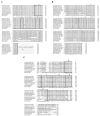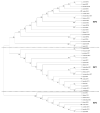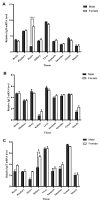Identification of Insulin-like Growth Factor (IGF) Family Genes in the Golden Pompano, Trachinotus ovatus: Molecular Cloning, Characterization and Gene Expression
- PMID: 38473747
- PMCID: PMC10931442
- DOI: 10.3390/ijms25052499
Identification of Insulin-like Growth Factor (IGF) Family Genes in the Golden Pompano, Trachinotus ovatus: Molecular Cloning, Characterization and Gene Expression
Abstract
Insulin-like growth factors (IGFs) are hormones that primarily stimulate and regulate animal physiological processes. In this study, we cloned and identified the open reading frame (ORF) cDNA sequences of IGF family genes: the insulin-like growth factor 1 (IGF1), insulin-like growth factor 2 (IGF2), and insulin-like growth factor 3 (IGF3). We found that IGF1, IGF2, and IGF3 have a total length of 558, 648, and 585 base pairs (bp), which encoded a predicted protein with 185, 215, and 194 amino acids (aa), respectively. Multiple sequences and phylogenetic tree analysis showed that the mature golden pompano IGFs had been conserved and showed high similarities with other teleosts. The tissue distribution experiment showed that IGF1 and IGF2 mRNA levels were highly expressed in the liver of female and male fish. In contrast, IGF3 was highly expressed in the gonads and livers of male and female fish, suggesting a high influence on fish reproduction. The effect of fasting showed that IGF1 and mRNA expression had no significant difference in the liver but significantly decreased after long-term (7 days) fasting in the muscles and started to recover after refeeding. IGF2 mRNA expression showed no significant difference in the liver but had a significant difference in muscles for short-term (2 days) and long-term fasting, which started to recover after refeeding, suggesting muscles are more susceptible to both short-term and long-term fasting. In vitro incubation of 17β-estradiol (E2) was observed to decrease the IGF1 and IGF3 mRNA expression level in a dose- (0.1, 1, and 10 μM) and time- (3, 6, and 12 h) dependent manner. In addition, E2 had no effect on IGF2 mRNA expression levels in a time- and dose-dependent manner. The effect of 17α-methyltestosterone (MT) in vitro incubation was observed to significantly increase the IGF3 mRNA expression level in a time- and dose-dependent manner. MT had no effect on IGF2 mRNA but was observed to decrease the IGF1 mRNA expression in the liver. Taken together, these data indicate that E2 and MT may either increase or decrease IGF expression in fish; this study provides basic knowledge and understanding of the expression and regulation of IGF family genes in relation to the nutritional status, somatic growth, and reproductive endocrinology of golden pompano for aquaculture development.
Keywords: IGFs; Trachinotus ovatus; cloning; fasting; fish reproduction; sex steroids.
Conflict of interest statement
The authors declare no conflicts of interest.
Figures








Similar articles
-
Integrated lncRNA and mRNA Transcriptome Analyses of IGF1 and IGF2 Stimulated Ovaries Reveal Genes and Pathways Potentially Associated with Ovarian Development and Oocyte Maturation in Golden Pompano (Trachinotus ovatus).Animals (Basel). 2025 Apr 15;15(8):1134. doi: 10.3390/ani15081134. Animals (Basel). 2025. PMID: 40281968 Free PMC article.
-
Molecular cloning of insulin-like growth factor 3 (igf3) and its expression in the tissues of a female damselfish, Chrysiptera cyanea, in relation to seasonal and food-manipulated reproduction.Gen Comp Endocrinol. 2020 Sep 1;295:113479. doi: 10.1016/j.ygcen.2020.113479. Epub 2020 Apr 1. Gen Comp Endocrinol. 2020. PMID: 32246963
-
Molecular characterization and transcriptional regulation by GH and GnRH of insulin-like growth factors I and II in white seabream (Diplodus sargus).Gene. 2016 Mar 10;578(2):251-62. doi: 10.1016/j.gene.2015.12.030. Epub 2015 Dec 17. Gene. 2016. PMID: 26706220
-
Insulin-like growth factors and fish reproduction.Biol Reprod. 2010 Apr;82(4):656-61. doi: 10.1095/biolreprod.109.080093. Epub 2009 Oct 28. Biol Reprod. 2010. PMID: 19864315 Review.
-
Targeting insulin-like growth factor 2 mRNA-binding proteins (IGF2BPs) for the treatment of cancer.Eur J Med Chem. 2024 Mar 15;268:116241. doi: 10.1016/j.ejmech.2024.116241. Epub 2024 Feb 15. Eur J Med Chem. 2024. PMID: 38382391 Review.
Cited by
-
Integrated lncRNA and mRNA Transcriptome Analyses of IGF1 and IGF2 Stimulated Ovaries Reveal Genes and Pathways Potentially Associated with Ovarian Development and Oocyte Maturation in Golden Pompano (Trachinotus ovatus).Animals (Basel). 2025 Apr 15;15(8):1134. doi: 10.3390/ani15081134. Animals (Basel). 2025. PMID: 40281968 Free PMC article.
-
Skin Telocytes Could Fundament the Cellular Mechanisms of Wound Healing in Platelet-Rich Plasma Administration.Cells. 2024 Aug 8;13(16):1321. doi: 10.3390/cells13161321. Cells. 2024. PMID: 39195210 Free PMC article. Review.
References
MeSH terms
Substances
LinkOut - more resources
Full Text Sources
Miscellaneous

